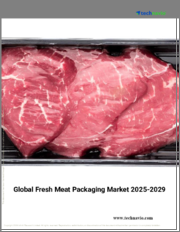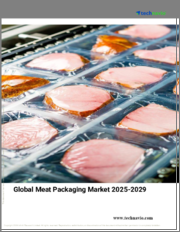
|
시장보고서
상품코드
1593983
육류 포장 시장 : 유형별, 포장 기술별, 제품 유형별, 육류 유형별 - 세계 예측(2025-2030년)Meat Packaging Market by Type (Flexible, Rigid, Semi-rigid), Packaging Technology (Aerobic Packaging, Functional Packaging, Modified Atmosphere Packaging), Product Type, Meat Type - Global Forecast 2025-2030 |
||||||
육류 포장 시장의 2023년 시장 규모는 105억 5,000만 달러로, 2024년에는 111억 6,000만 달러에 달할 것으로 예측되며, CAGR 5.88%로 성장하며, 2030년에는 157억 5,000만 달러에 달할 것으로 예측됩니다.
육류 포장 시장은 도축에서 판매까지 육류 제품의 보호, 보존 및 진열에 중점을 둔 광범위한 식품 포장 산업의 필수적인 부분입니다. 육류 포장의 필요성은 식품의 안전성을 유지하고, 유통기한을 연장하고, 오염을 방지하고, 소비자에게 편리함과 정보를 제공해야 할 필요성에서 비롯됩니다. 진공포장 및 가스 대체 포장부터 능동형 포장 기술까지 다양한 용도가 있으며, 소매, 외식 및 산업 부문의 다양한 최종 사용 시나리오에 맞게 조정됩니다. 이 시장에 영향을 미치는 성장 요인으로는 단백질이 풍부한 식단에 대한 세계 수요 증가, 도시화, 편리하고 바로 먹을 수 있는 육류 제품에 대한 소비자 선호도 등이 있습니다. 지속가능하고 스마트한 포장 솔루션의 기술 발전은 시장 참여자들에게 차별화를 위한 큰 기회가 될 수 있습니다. 생분해성 필름, 재활용 가능한 플라스틱과 같은 친환경 소재에 대한 수요는 소비자 동향과 규제 압력과 맞물려 혁신의 길을 제시하고 있습니다.
| 주요 시장 통계 | |
|---|---|
| 기준년[2023년] | 105억 5,000만 달러 |
| 예측년[2024년] | 111억 6,000만 달러 |
| 예측년[2030년] | 157억 5,000만 달러 |
| CAGR(%) | 5.88% |
시간 온도 표시기와 같은 스마트 포장 기술을 채택하면 공급망 투명성과 제품 품질 모니터링을 강화할 수 있습니다. 그러나 이 시장은 원자재 가격 변동, 재료 관련 규제 제약, 플라스틱 폐기물에 대한 우려와 같은 제약과 과제에 직면해 있습니다. 세계 시장에서 일관된 규정 준수의 어려움과 새로운 기술을 통합하기 위한 연구개발에 대한 막대한 투자 필요성은 또 다른 장애물이 되고 있습니다. 시장 경쟁은 치열하며, 주요 시장 진출기업은 경쟁력을 확보하기 위해 지속가능성과 효율성을 강화하는 데 주력하고 있습니다. 기술 혁신 부문에는 식물 유래 바이오플라스틱의 사용 확대, 소비자 안전을 개선하고 유통기한을 연장하는 지능형 포장 솔루션 개발 등이 포함됩니다. 기업은 이러한 기회를 활용하기 위해 기술 기업과의 파트너십과 지속가능성에 초점을 맞춘 연구개발에 투자해야 합니다. 시장의 역동적인 특성으로 인해 소비자 선호도, 법 개정, 기술 발전에 민감하게 반응하므로 현재의 과제를 해결하고 새로운 기회를 활용하기 위한 적극적인 전략 계획이 필요합니다.
시장 역학: 빠르게 진화하는 육류 포장 시장의 주요 시장 인사이트를 공개합니다.
육류 포장 시장은 수요 및 공급의 역동적인 상호작용에 의해 변화하고 있습니다. 이러한 시장 역학의 변화를 이해함으로써 기업은 정보에 입각한 투자 결정을 내리고, 전략적인 의사결정을 정교화하며, 새로운 비즈니스 기회를 포착할 수 있습니다. 이러한 동향을 종합적으로 파악함으로써 기업은 정치적, 지역적, 기술적, 사회적, 경제적 영역 전반에 걸친 다양한 리스크를 줄일 수 있으며, 소비자 행동과 그것이 제조 비용 및 구매 동향에 미치는 영향을 보다 명확하게 이해할 수 있습니다.
- 시장 성장 촉진요인
- 육류 및 육류 제품 소비 및 거래 증가
- 육류 제품 보관 및 유통 과정에서의 오염 방지 필요성
- 소매 제품에 진공포장 및 가스 대체 포장(MAP) 사용 증가
- 시장 성장 억제요인
- 포장육과 관련된 미세 플라스틱 오염 문제
- 시장 기회
- 신선한 육류 및 가공육 제품을 위한 혁신적인 포장 솔루션 도입
- 육류 제품에 대한 지능형 지속가능한 포장의 활용 증가
- 시장 과제
- 포장 폐기물에 따른 환경 문제
Porter's Five Forces: 육류 포장 시장 공략을 위한 전략 툴
Porter's Five Forces 프레임워크는 시장 상황경쟁 구도를 이해하는 데 중요한 툴입니다. Porter의 Five Forces 프레임워크는 기업의 경쟁을 평가하고 전략적 기회를 모색하기 위한 명확한 방법을 설명합니다. 이 프레임워크는 기업이 시장내 세력도를 평가하고 신규 사업의 수익성을 판단하는 데 도움이 됩니다. 이러한 인사이트을 통해 기업은 강점을 활용하고 약점을 보완하며 잠재적 도전을 피함으로써 보다 강력한 시장 포지셔닝을 확보할 수 있습니다.
PESTLE 분석 : 육류 포장 시장의 외부 영향 파악
외부 거시 환경 요인은 육류 포장 시장의 성과 역학을 형성하는 데 매우 중요한 역할을 합니다. 정치적, 경제적, 사회적, 기술적, 법적, 환경적 요인에 대한 분석은 이러한 영향을 탐색하는 데 필요한 정보를 담고 있으며, PESTLE 요인을 조사함으로써 기업은 잠재적인 위험과 기회를 더 잘 이해할 수 있습니다. 이러한 분석을 통해 기업은 규제, 소비자 선호도, 경제 동향의 변화를 예측하고 선제적이고 적극적인 의사결정을 내릴 준비를 할 수 있습니다.
시장 점유율 분석 : 육류 포장 시장에서 경쟁 구도 파악
육류 포장 시장의 상세한 시장 점유율 분석을 통해 공급업체의 성과를 종합적으로 평가할 수 있습니다. 기업은 매출, 고객 기반, 성장률과 같은 주요 지표를 비교하여 경쟁적 위치를 파악할 수 있습니다. 이 분석은 시장의 집중화, 세분화 및 통합 추세를 파악하여 공급업체가 치열한 경쟁에서 자신의 입지를 강화할 수 있는 전략적 의사결정을 내리는 데 필요한 인사이트을 제공합니다.
FPNV 포지셔닝 매트릭스: 육류 포장 시장에서공급업체 성과 평가
FPNV 포지셔닝 매트릭스는 육류 포장 시장에서 공급업체를 평가하는 중요한 툴입니다. 이 매트릭스를 통해 비즈니스 조직은 벤더의 비즈니스 전략과 제품 만족도를 기반으로 벤더를 평가하여 목표에 부합하는 정보에 입각한 의사결정을 내릴 수 있으며, 4개의 사분면으로 벤더를 명확하고 정확하게 세분화하여 전략 목표에 가장 적합한 파트너와 솔루션을 식별할 수 있습니다. 전략 목표에 가장 적합한 파트너와 솔루션을 식별할 수 있습니다.
전략 분석 및 추천: 육류 포장 시장에서 성공으로 가는 길 차트
육류 포장 시장 전략 분석은 세계 시장에서 입지를 강화하고자 하는 기업에게 필수적입니다. 주요 자원, 역량 및 성과 지표를 검토함으로써 기업은 성장 기회를 식별하고 개선할 수 있습니다. 이러한 접근 방식을 통해 경쟁 환경의 도전을 극복하고 새로운 비즈니스 기회를 활용하여 장기적인 성공을 거둘 수 있도록 준비할 수 있습니다.
이 보고서는 주요 관심 부문에 대한 종합적인 시장 분석을 제공합니다.
1. 시장 침투도 : 현재 시장 환경의 상세한 검토, 주요 기업의 광범위한 데이터, 시장 도달 범위 및 전반적인 영향력을 평가합니다.
2. 시장 개척도: 신흥 시장에서의 성장 기회를 파악하고, 기존 부문의 확장 가능성을 평가하며, 미래 성장을 위한 전략적 로드맵을 기술하고 있습니다.
3. 시장 다각화 : 최근 제품 출시, 미개척 지역, 산업의 주요 발전, 시장을 형성하는 전략적 투자를 분석합니다.
4. 경쟁 평가 및 정보 : 경쟁 구도를 철저히 분석하여 시장 점유율, 사업 전략, 제품 포트폴리오, 인증, 규제 당국의 승인, 특허 동향, 주요 기업의 기술 발전 등을 검토합니다.
5. 제품 개발 및 혁신 : 미래 시장 성장을 가속할 것으로 예상되는 첨단 기술, 연구개발 활동 및 제품 혁신을 강조합니다.
또한 이해관계자들이 충분한 정보를 바탕으로 의사결정을 내릴 수 있도록 중요한 질문에 대한 답변도 제공합니다.
1. 현재 시장 규모와 향후 성장 전망은?
2. 최고의 투자 기회를 제공하는 제품, 지역은?
3. 시장을 형성하는 주요 기술 동향과 규제의 영향은?
4. 주요 벤더 시장 점유율과 경쟁 포지션은?
5. 벤더 시장 진입 및 철수 전략의 원동력이 되는 수입원과 전략적 기회는 무엇인가?
목차
제1장 서문
제2장 조사 방법
제3장 개요
제4장 시장 개요
제5장 시장 인사이트
- 시장 역학
- 성장 촉진요인
- 성장 억제요인
- 기회
- 과제
- 시장 세분화 분석
- Porter's Five Forces 분석
- PESTEL 분석
- 정치
- 경제
- 사회
- 기술
- 법률
- 환경
제6장 육류 포장 시장 : 유형별
- 서론
- 연질
- 알루미늄 포일
- 플라스틱
- 에틸렌 비닐 알코올(EVOH)
- 발포 폴리스티렌(EPS)
- 폴리아미드(PA)
- 폴리에틸렌(PE)
- 폴리에틸렌 테레프탈레이트(PETE)
- 폴리프로필렌(PP)
- 폴리염화비닐(PVC)
- 경질
- 유리
- 금속
- 알루미늄
- 스테인리스강
- 주석
- 반경질
- 종이·판지
- 플라스틱 용기
제7장 육류 포장 시장 : 포장 기술별
- 서론
- 호기성 포장
- 기능성 포장
- 활성포장
- 항균 포장
- 가스 치환 포장
- 진공포장
제8장 육류 포장 시장 : 제품 유형별
- 서론
- 신선
- 가공
제9장 육류 포장 시장 : 육류 유형별
- 서론
- 소고기
- 돼지고기
- 가금육
- 어개류
제10장 아메리카의 육류 포장 시장
- 서론
- 아르헨티나
- 브라질
- 캐나다
- 멕시코
- 미국
제11장 아시아태평양의 육류 포장 시장
- 서론
- 호주
- 중국
- 인도
- 인도네시아
- 일본
- 말레이시아
- 필리핀
- 싱가포르
- 한국
- 대만
- 태국
- 베트남
제12장 유럽, 중동 및 아프리카의 육류 포장 시장
- 서론
- 덴마크
- 이집트
- 핀란드
- 프랑스
- 독일
- 이스라엘
- 이탈리아
- 네덜란드
- 나이지리아
- 노르웨이
- 폴란드
- 카타르
- 러시아
- 사우디아라비아
- 남아프리카공화국
- 스페인
- 스웨덴
- 스위스
- 터키
- 아랍에미리트
- 영국
제13장 경쟁 구도
- 시장 점유율 분석, 2023년
- FPNV 포지셔닝 매트릭스, 2023년
- 경쟁 시나리오 분석
- 전략 분석과 제안
언급된 기업
- adapa Holding GesmbH
- Amcor PLC
- Amerplast Ltd.
- Berry Global Group, Inc.
- Bollore SE
- Cascades Inc.
- Clondalkin Group
- Constantia Flexibles International GmbH
- Coveris Management GmbH
- DS Smith PLC
- EasyPak LLC
- Exxon Mobil Corporation
- Faerch A/S
- Goglio S.p.A.
- Graphic Packaging Holding Company
- Kureha Corporation
- Mondi PLC
- Pactiv Evergreen Inc.
- PPC Flexible Packaging LLC
- ProAmpac Intermediate, Inc.
- Sealed Air Corporation
- Sealpac International B.V.
- Smurfit Kappa Group PLC
- Sonoco Products Company
- Sudpack Holding GmbH
- The Dow Chemical Company
- ULMA Group
- WestRock Company
- WINPAK LTD.
- Wipak Group
The Meat Packaging Market was valued at USD 10.55 billion in 2023, expected to reach USD 11.16 billion in 2024, and is projected to grow at a CAGR of 5.88%, to USD 15.75 billion by 2030.
The meat packaging market is an integral part of the broader food packaging industry, focusing on protecting, preserving, and presenting meat products from slaughter to point-of-sale. The necessity of meat packaging arises from the need to maintain food safety, extend shelf life, prevent contamination, and provide convenience and information to consumers. Applications range from vacuum packaging and modified atmosphere packaging to active packaging technologies, tailored to meet diverse end-use scenarios in retail, food service, and industrial sectors. Growth factors influencing this market include rising global demand for protein-rich diets, increasing urbanization, and consumer preference for convenient, ready-to-eat meat products. Technological advancements in sustainable and smart packaging solutions present substantial opportunities for market players to differentiate themselves. The push for environmentally-friendly materials, such as biodegradable films and recyclable plastics, aligns with consumer trends and regulatory pressures, offering pathways to innovation.
| KEY MARKET STATISTICS | |
|---|---|
| Base Year [2023] | USD 10.55 billion |
| Estimated Year [2024] | USD 11.16 billion |
| Forecast Year [2030] | USD 15.75 billion |
| CAGR (%) | 5.88% |
Adopting smart packaging technologies, such as time-temperature indicators, can enhance supply chain transparency and product quality monitoring. However, the market faces limitations and challenges, including fluctuating raw material prices, regulatory constraints on materials, and concerns over plastic waste. Difficulties in ensuring consistent compliance across global markets and the need for significant investment in R&D to integrate novel technologies pose further hurdles. The market is highly competitive, with key players focusing on enhancing sustainability and efficiency to gain a competitive edge. Areas of innovation include expanding the use of plant-based bio-plastics and developing intelligent packaging solutions that improve consumer safety and extend shelf life. Companies should invest in collaborations with technology firms and sustainability-focused R&D to tap into these opportunities. Given its dynamic nature, the market is responsive to trends in consumer preferences, legislative changes, and technological advancements, necessitating proactive strategic planning to capitalize on emerging opportunities while addressing present challenges.
Market Dynamics: Unveiling Key Market Insights in the Rapidly Evolving Meat Packaging Market
The Meat Packaging Market is undergoing transformative changes driven by a dynamic interplay of supply and demand factors. Understanding these evolving market dynamics prepares business organizations to make informed investment decisions, refine strategic decisions, and seize new opportunities. By gaining a comprehensive view of these trends, business organizations can mitigate various risks across political, geographic, technical, social, and economic domains while also gaining a clearer understanding of consumer behavior and its impact on manufacturing costs and purchasing trends.
- Market Drivers
- Rising consumption and trade of meat and meat products
- Need to prevent meat products from contamination during storage and distribution
- Increasing use of vacuum and modified atmosphere packaging (MAP) for retail products
- Market Restraints
- Microplastic contamination issues associated with packaged meat
- Market Opportunities
- Introduction of innovative packaging solutions for fresh and processed meat products
- Emerging use of intelligent and sustainable packaging for meat products
- Market Challenges
- Environmental concerns associated with the disposal of packaging
Porter's Five Forces: A Strategic Tool for Navigating the Meat Packaging Market
Porter's five forces framework is a critical tool for understanding the competitive landscape of the Meat Packaging Market. It offers business organizations with a clear methodology for evaluating their competitive positioning and exploring strategic opportunities. This framework helps businesses assess the power dynamics within the market and determine the profitability of new ventures. With these insights, business organizations can leverage their strengths, address weaknesses, and avoid potential challenges, ensuring a more resilient market positioning.
PESTLE Analysis: Navigating External Influences in the Meat Packaging Market
External macro-environmental factors play a pivotal role in shaping the performance dynamics of the Meat Packaging Market. Political, Economic, Social, Technological, Legal, and Environmental factors analysis provides the necessary information to navigate these influences. By examining PESTLE factors, businesses can better understand potential risks and opportunities. This analysis enables business organizations to anticipate changes in regulations, consumer preferences, and economic trends, ensuring they are prepared to make proactive, forward-thinking decisions.
Market Share Analysis: Understanding the Competitive Landscape in the Meat Packaging Market
A detailed market share analysis in the Meat Packaging Market provides a comprehensive assessment of vendors' performance. Companies can identify their competitive positioning by comparing key metrics, including revenue, customer base, and growth rates. This analysis highlights market concentration, fragmentation, and trends in consolidation, offering vendors the insights required to make strategic decisions that enhance their position in an increasingly competitive landscape.
FPNV Positioning Matrix: Evaluating Vendors' Performance in the Meat Packaging Market
The Forefront, Pathfinder, Niche, Vital (FPNV) Positioning Matrix is a critical tool for evaluating vendors within the Meat Packaging Market. This matrix enables business organizations to make well-informed decisions that align with their goals by assessing vendors based on their business strategy and product satisfaction. The four quadrants provide a clear and precise segmentation of vendors, helping users identify the right partners and solutions that best fit their strategic objectives.
Strategy Analysis & Recommendation: Charting a Path to Success in the Meat Packaging Market
A strategic analysis of the Meat Packaging Market is essential for businesses looking to strengthen their global market presence. By reviewing key resources, capabilities, and performance indicators, business organizations can identify growth opportunities and work toward improvement. This approach helps businesses navigate challenges in the competitive landscape and ensures they are well-positioned to capitalize on newer opportunities and drive long-term success.
Key Company Profiles
The report delves into recent significant developments in the Meat Packaging Market, highlighting leading vendors and their innovative profiles. These include adapa Holding GesmbH, Amcor PLC, Amerplast Ltd., Berry Global Group, Inc., Bollore SE, Cascades Inc., Clondalkin Group, Constantia Flexibles International GmbH, Coveris Management GmbH, DS Smith PLC, EasyPak LLC, Exxon Mobil Corporation, Faerch A/S, Goglio S.p.A., Graphic Packaging Holding Company, Kureha Corporation, Mondi PLC, Pactiv Evergreen Inc., PPC Flexible Packaging LLC, ProAmpac Intermediate, Inc., Sealed Air Corporation, Sealpac International B.V., Smurfit Kappa Group PLC, Sonoco Products Company, Sudpack Holding GmbH, The Dow Chemical Company, ULMA Group, WestRock Company, WINPAK LTD., and Wipak Group.
Market Segmentation & Coverage
This research report categorizes the Meat Packaging Market to forecast the revenues and analyze trends in each of the following sub-markets:
- Based on Type, market is studied across Flexible, Rigid, and Semi-rigid. The Flexible is further studied across Aluminum Foils and Plastic. The Plastic is further studied across Ethylenvinyl Alcohol (EVOH), Expanded polystyrene (EPS), Polyamide (PA), Polyethylene (PE), Polyethylene terephthalate (PETE), Polypropylene (PP), and Polyvinylchloride (PVC). The Rigid is further studied across Glass and Metal. The Metal is further studied across Aluminum, Stainless Steel, and Tin. The Semi-rigid is further studied across Paper & Paperboards and Plastic Containers.
- Based on Packaging Technology, market is studied across Aerobic Packaging, Functional Packaging, Modified Atmosphere Packaging, and Vacuum Packaging. The Functional Packaging is further studied across Active Packaging and Antimicrobial Packaging.
- Based on Product Type, market is studied across Fresh and Processed.
- Based on Meat Type, market is studied across Beef, Pork, Poultry, and Seafood.
- Based on Region, market is studied across Americas, Asia-Pacific, and Europe, Middle East & Africa. The Americas is further studied across Argentina, Brazil, Canada, Mexico, and United States. The United States is further studied across California, Florida, Illinois, New York, Ohio, Pennsylvania, and Texas. The Asia-Pacific is further studied across Australia, China, India, Indonesia, Japan, Malaysia, Philippines, Singapore, South Korea, Taiwan, Thailand, and Vietnam. The Europe, Middle East & Africa is further studied across Denmark, Egypt, Finland, France, Germany, Israel, Italy, Netherlands, Nigeria, Norway, Poland, Qatar, Russia, Saudi Arabia, South Africa, Spain, Sweden, Switzerland, Turkey, United Arab Emirates, and United Kingdom.
The report offers a comprehensive analysis of the market, covering key focus areas:
1. Market Penetration: A detailed review of the current market environment, including extensive data from top industry players, evaluating their market reach and overall influence.
2. Market Development: Identifies growth opportunities in emerging markets and assesses expansion potential in established sectors, providing a strategic roadmap for future growth.
3. Market Diversification: Analyzes recent product launches, untapped geographic regions, major industry advancements, and strategic investments reshaping the market.
4. Competitive Assessment & Intelligence: Provides a thorough analysis of the competitive landscape, examining market share, business strategies, product portfolios, certifications, regulatory approvals, patent trends, and technological advancements of key players.
5. Product Development & Innovation: Highlights cutting-edge technologies, R&D activities, and product innovations expected to drive future market growth.
The report also answers critical questions to aid stakeholders in making informed decisions:
1. What is the current market size, and what is the forecasted growth?
2. Which products, segments, and regions offer the best investment opportunities?
3. What are the key technology trends and regulatory influences shaping the market?
4. How do leading vendors rank in terms of market share and competitive positioning?
5. What revenue sources and strategic opportunities drive vendors' market entry or exit strategies?
Table of Contents
1. Preface
- 1.1. Objectives of the Study
- 1.2. Market Segmentation & Coverage
- 1.3. Years Considered for the Study
- 1.4. Currency & Pricing
- 1.5. Language
- 1.6. Stakeholders
2. Research Methodology
- 2.1. Define: Research Objective
- 2.2. Determine: Research Design
- 2.3. Prepare: Research Instrument
- 2.4. Collect: Data Source
- 2.5. Analyze: Data Interpretation
- 2.6. Formulate: Data Verification
- 2.7. Publish: Research Report
- 2.8. Repeat: Report Update
3. Executive Summary
4. Market Overview
5. Market Insights
- 5.1. Market Dynamics
- 5.1.1. Drivers
- 5.1.1.1. Rising consumption and trade of meat and meat products
- 5.1.1.2. Need to prevent meat products from contamination during storage and distribution
- 5.1.1.3. Increasing use of vacuum and modified atmosphere packaging (MAP) for retail products
- 5.1.2. Restraints
- 5.1.2.1. Microplastic contamination issues associated with packaged meat
- 5.1.3. Opportunities
- 5.1.3.1. Introduction of innovative packaging solutions for fresh and processed meat products
- 5.1.3.2. Emerging use of intelligent and sustainable packaging for meat products
- 5.1.4. Challenges
- 5.1.4.1. Environmental concerns associated with the disposal of packaging
- 5.1.1. Drivers
- 5.2. Market Segmentation Analysis
- 5.3. Porter's Five Forces Analysis
- 5.3.1. Threat of New Entrants
- 5.3.2. Threat of Substitutes
- 5.3.3. Bargaining Power of Customers
- 5.3.4. Bargaining Power of Suppliers
- 5.3.5. Industry Rivalry
- 5.4. PESTLE Analysis
- 5.4.1. Political
- 5.4.2. Economic
- 5.4.3. Social
- 5.4.4. Technological
- 5.4.5. Legal
- 5.4.6. Environmental
6. Meat Packaging Market, by Type
- 6.1. Introduction
- 6.2. Flexible
- 6.2.1. Aluminum Foils
- 6.2.2. Plastic
- 6.2.2.1. Ethylenvinyl Alcohol (EVOH)
- 6.2.2.2. Expanded polystyrene (EPS)
- 6.2.2.3. Polyamide (PA)
- 6.2.2.4. Polyethylene (PE)
- 6.2.2.5. Polyethylene terephthalate (PETE)
- 6.2.2.6. Polypropylene (PP)
- 6.2.2.7. Polyvinylchloride (PVC)
- 6.3. Rigid
- 6.3.1. Glass
- 6.3.2. Metal
- 6.3.2.1. Aluminum
- 6.3.2.2. Stainless Steel
- 6.3.2.3. Tin
- 6.4. Semi-rigid
- 6.4.1. Paper & Paperboards
- 6.4.2. Plastic Containers
7. Meat Packaging Market, by Packaging Technology
- 7.1. Introduction
- 7.2. Aerobic Packaging
- 7.3. Functional Packaging
- 7.3.1. Active Packaging
- 7.3.2. Antimicrobial Packaging
- 7.4. Modified Atmosphere Packaging
- 7.5. Vacuum Packaging
8. Meat Packaging Market, by Product Type
- 8.1. Introduction
- 8.2. Fresh
- 8.3. Processed
9. Meat Packaging Market, by Meat Type
- 9.1. Introduction
- 9.2. Beef
- 9.3. Pork
- 9.4. Poultry
- 9.5. Seafood
10. Americas Meat Packaging Market
- 10.1. Introduction
- 10.2. Argentina
- 10.3. Brazil
- 10.4. Canada
- 10.5. Mexico
- 10.6. United States
11. Asia-Pacific Meat Packaging Market
- 11.1. Introduction
- 11.2. Australia
- 11.3. China
- 11.4. India
- 11.5. Indonesia
- 11.6. Japan
- 11.7. Malaysia
- 11.8. Philippines
- 11.9. Singapore
- 11.10. South Korea
- 11.11. Taiwan
- 11.12. Thailand
- 11.13. Vietnam
12. Europe, Middle East & Africa Meat Packaging Market
- 12.1. Introduction
- 12.2. Denmark
- 12.3. Egypt
- 12.4. Finland
- 12.5. France
- 12.6. Germany
- 12.7. Israel
- 12.8. Italy
- 12.9. Netherlands
- 12.10. Nigeria
- 12.11. Norway
- 12.12. Poland
- 12.13. Qatar
- 12.14. Russia
- 12.15. Saudi Arabia
- 12.16. South Africa
- 12.17. Spain
- 12.18. Sweden
- 12.19. Switzerland
- 12.20. Turkey
- 12.21. United Arab Emirates
- 12.22. United Kingdom
13. Competitive Landscape
- 13.1. Market Share Analysis, 2023
- 13.2. FPNV Positioning Matrix, 2023
- 13.3. Competitive Scenario Analysis
- 13.3.1. SugarCreek Packing Acquires Italian Meat Processor Veroni S.p.A.
- 13.3.2. Eviosys Invests in Turkiye and Introduces Rectangular Luncheon Meat Can to Meet Growing Market Demand
- 13.3.3. Noel Alimentaria to Use Mondi's Paper-Based Food Packaging
- 13.3.4. C-P Flexible Packaging and Volpi Foods Launch First Fully Compostable Package for Packaged Deli Meats
- 13.4. Strategy Analysis & Recommendation
Companies Mentioned
- 1. adapa Holding GesmbH
- 2. Amcor PLC
- 3. Amerplast Ltd.
- 4. Berry Global Group, Inc.
- 5. Bollore SE
- 6. Cascades Inc.
- 7. Clondalkin Group
- 8. Constantia Flexibles International GmbH
- 9. Coveris Management GmbH
- 10. DS Smith PLC
- 11. EasyPak LLC
- 12. Exxon Mobil Corporation
- 13. Faerch A/S
- 14. Goglio S.p.A.
- 15. Graphic Packaging Holding Company
- 16. Kureha Corporation
- 17. Mondi PLC
- 18. Pactiv Evergreen Inc.
- 19. PPC Flexible Packaging LLC
- 20. ProAmpac Intermediate, Inc.
- 21. Sealed Air Corporation
- 22. Sealpac International B.V.
- 23. Smurfit Kappa Group PLC
- 24. Sonoco Products Company
- 25. Sudpack Holding GmbH
- 26. The Dow Chemical Company
- 27. ULMA Group
- 28. WestRock Company
- 29. WINPAK LTD.
- 30. Wipak Group

















